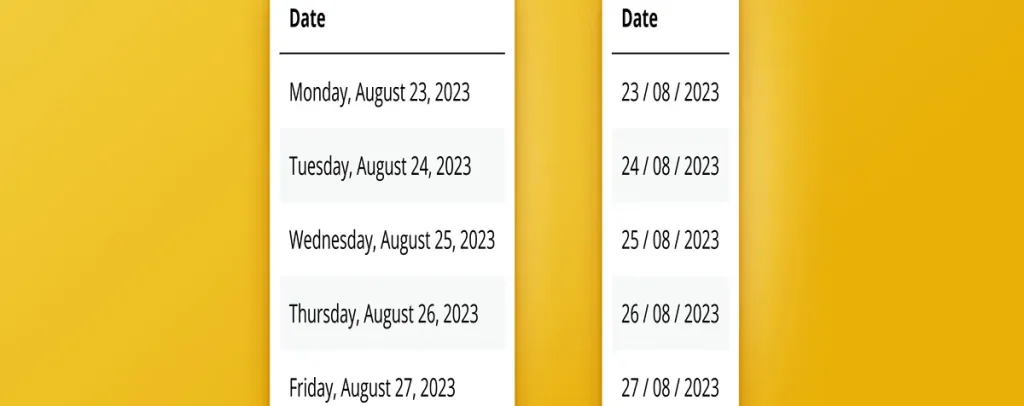Dominate Date Formatting: The Latest JavaScript Techniques You Need to Know in 2024!

How to Automatically Do Date Formatting?
Introduction:
In the realm of web development, user input validation is paramount, especially when it comes to dates. Incorrectly formatted dates can lead to errors and frustration for users. In this guide, we’ll delve into the intricacies of date input handling in JavaScript and explore how to automatically format dates as users type.
Understanding Date Input Handling in JavaScript
JavaScript provides powerful tools for handling user input, including dates. However, formatting dates dynamically as users type can be challenging. Let’s break down the process step by step.
Basic Input Handling
To begin, let’s understand the basic principles of date input handling in JavaScript. Below is a sample function that demonstrates how to automatically format dates:
function formatDate(textBox) {
var date = textBox.value;
// Check if the input length is at least 2 characters (minimum length for day)
if (date.length >= 2) {
// Automatically add a hyphen "-" after the day
if (date.length === 2 && date.indexOf("-") === -1) {
date += "-";
textBox.value = date;
return;
}
// Check if the input length is at least 5 characters (minimum length for "dd-MM")
if (date.length >= 5) {
// Automatically add a hyphen "-" after the month
if (date.length === 5 && date.lastIndexOf("-") === 2) {
date += "-";
textBox.value = date;
return;
}
}
// Check if the input length is at least 8 characters (minimum length for "dd-MM-yyyy")
if (date.length >= 8) {
var day = date.substring(0, 2);
var month = date.substring(3, 5);
var year = date.substring(6, 10);
// Check if all parts of the date are numeric
if (!isNaN(day) && !isNaN(month) && !isNaN(year)) {
// Ensure month is within valid range (1 to 12)
if (parseInt(month) > 12) {
// If month is greater than 12, set it to 12
month = "12";
}
// Ensure day is within valid range for the specified month and year
var lastDayOfMonth = new Date(year, month, 0).getDate();
if (parseInt(day) > lastDayOfMonth) {
// If day is greater than the last day of the month, set it to the last day
day = lastDayOfMonth.toString().padStart(2, '0');
}
// Construct the formatted date string "dd-MM-yyyy"
var formattedDate = day + "-" + month + "-" + year;
// Update the TextBox value with the formatted date
textBox.value = formattedDate;
}
}
}
}
Implementation in Web Applications
Now that we understand the principles of date input handling in JavaScript, let’s explore how to implement this functionality in web applications. Whether you’re building a simple form or a complex data entry system, integrating dynamic date formatting can greatly improve usability.
Integration with HTML Forms
You can easily integrate the formatDate function with HTML forms by attaching it to the onkeyup event of date input fields. This allows for real-time formatting of dates as users type, providing instant feedback and guidance.
<input type="text" id="dateInput" onkeyup="formatDate(this);">
Customization and Extensibility
The provided formatDate function serves as a foundation for customizing and extending date input handling in your web applications. Depending on your specific requirements, you can modify the function to support different date formats or incorporate additional validation rules.
Conclusion:
In conclusion, mastering date input handling in JavaScript serves as a fundamental pillar in the development of modern web applications. The ability to effectively manage and validate date inputs not only ensures data integrity but also plays a significant role in enhancing the user experience. Through the utilization of dynamic date formatting techniques, such as the formatDate function demonstrated in this guide, developers can streamline the date entry process and mitigate the risk of user errors.
Implementing dynamic date formatting empowers users by providing real-time feedback and guidance as they input dates into forms or interact with date-related components. By automatically formatting dates as users type, unnecessary friction is reduced, and the overall usability of the application is improved. This not only enhances user satisfaction but also reduces frustration and increases efficiency in data entry workflows.
Furthermore, dynamic date formatting contributes to the creation of robust and user-friendly web applications. By enforcing consistency in date formats and performing validation checks in real-time, developers can ensure that the data entered by users meets the required standards. This helps prevent data inconsistencies and errors downstream, ultimately leading to a more reliable and trustworthy application.
In essence, mastering date input handling in JavaScript is not just about technical proficiency; it’s about prioritizing user experience and data integrity. By embracing dynamic date formatting techniques and incorporating them into your development workflow, you can create web applications that are both intuitive to use and dependable in handling date-related data.
FAQs:
Q: Why is mastering date input handling important in JavaScript?
Answer: Mastering date input handling in JavaScript is crucial because dates are a common form of user input in web applications. Effective handling ensures data integrity and enhances user experience by providing seamless interactions with date-related components.
Q: How does dynamic date formatting improve usability?
Answer: Dynamic date formatting improves usability by providing real-time feedback to users as they input dates. By automatically formatting dates as users type, errors are minimized, and users receive instant guidance, reducing frustration and streamlining the date entry process.
Q: Can I customize the formatDate function for specific date formats?
Answer: Yes, the formatDate function can be customized to support various date formats and validation rules based on your application’s requirements. You can modify the function to accommodate different date input formats and implement additional validation checks as needed.
Q: What are the performance considerations when implementing date input handling in JavaScript?
Answer: While date input handling in JavaScript is generally lightweight, it’s essential to optimize code for efficiency, especially in applications with high user traffic. Minimizing unnecessary function calls and ensuring efficient event handling can help maintain optimal performance.
Q: Are there any other input validation techniques that can be applied to enhance data integrity in web applications?
Answer: Yes, in addition to date input handling, web developers can implement various input validation techniques such as form validation, input sanitization, and data normalization. These techniques help ensure data integrity and security across all aspects of user input in web applications.




